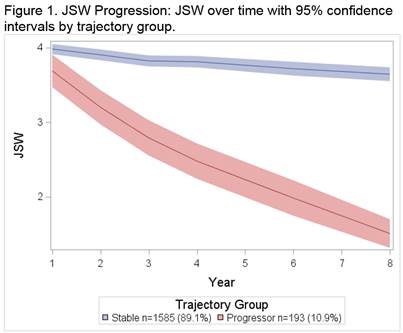Session Information
Session Type: ACR/ARHP Combined Abstract Session
Session Time: 2:30PM-4:00PM
Background/Purpose: The link between progression of structure and symptoms in knee osteoarthritis (OA) is not well understood. This uncertainty hinders the effort to develop therapies to treat OA symptoms because it is unclear how treating structure or halting structural progression might alleviate symptoms.
Methods: We used data from the Osteoarthritis Initiative (OAI), a multicenter, longitudinal, observational study of knee OA. We selected patients with baseline (BL) Kellgren-Lawrence (KL) grade 1 – 3 and knee pain. Medial minimum joint space width (JSW) was assessed with a fixed-flexion knee radiograph annually through year 4 and then at years 6 and 8. WOMAC pain was assessed annually. We censored subjects at the time of any reported TKR. We used latent class growth analysis (LCGA) to identify distinct subgroups of JSW progression and pain progression. We included random effects to allow for within-subject variability. We analyzed data from years 1 to 8. We used logistic regression to evaluate the association between JSW and pain trajectories identified in LCGA analysis.
Results: We used data from 1,909 OAI study participants. BL radiographic severity was KL1 in 16%, KL2 in 52%, and KL3 in 32%. The mean (SD) JSW was 4.0mm (1.3). LCGA identified 2 distinct JSW trajectories: most patients (89%) had stable JSW over 8 years of follow-up, while a subgroup of patients (11%) experienced rapid disease progression [Figure 1]. We found 4 distinct pain trajectories. Most patients (75%) had stable low pain. There were also distinct trajectories of decreasing (5%), increasing (10%) and high stable (11%) pain [Figure 2]. The probability of being a rapid JSW progressor in each pain trajectory was 14% (high), 14% (increasing), 16% (decreasing), and 9% (low). This translates to an increased odds of being in the JSW progressor group in the high stable pain (OR: 1.6; 95%CI: 1.0, 2.4); increasing pain (OR 1.5; 95%CI: 0.98, 2.4) and deceasing pain (OR: 1.9; 95%CI: 1.0, 3.4)) groups compared to low stable pain group.
Conclusion: We found distinct subgroups of both JSW and pain progression. While subjects in the low stable pain trajectory had a slightly decreased odds of JSW progression, we did not find differences in the risk of being a rapid JSW progressor between the increasing, decreasing, and high pain groups. Future work should consider whether additional joint features as visualized on MRI, such as cartilage, osteophytes, bone marrow lesions, and synovitis, may help to elucidate the link between structural and symptomatic progression.
To cite this abstract in AMA style:
Collins JE, Shrestha S, Losina E. The Association between Structural and Symptomatic Progression in Knee Osteoarthritis [abstract]. Arthritis Rheumatol. 2018; 70 (suppl 9). https://acrabstracts.org/abstract/the-association-between-structural-and-symptomatic-progression-in-knee-osteoarthritis/. Accessed .« Back to 2018 ACR/ARHP Annual Meeting
ACR Meeting Abstracts - https://acrabstracts.org/abstract/the-association-between-structural-and-symptomatic-progression-in-knee-osteoarthritis/


